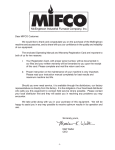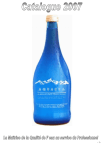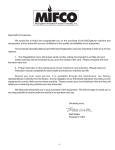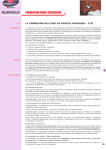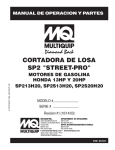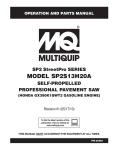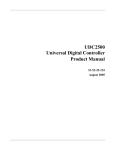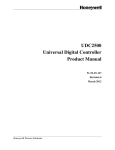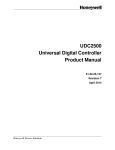Download Watlow Electric 945 Instruction manual
Transcript
Dear MIFCO Customer: We would like to thank and congratulate you on the purchase of the McEnglevan machine and accessories, and to share with you our confidence in the quality and reliability of our equipment. The enclosed Operating Manual and Warranty Registration Card are important to both of us for two reasons: l. Your Registration Card, with proper serial number, will be documented in our files and your written warranty will be forwarded to you upon the receipt of this card. Please complete and mail the return card now. 2. Proper instruction on the maintenance of your machine is very important. Please read your instruction manual completely for best results and maximum machine tool life. Should you ever need service, it is available through the distributors, our factory representatives or directly from the factory. It is the obligation of our franchised distributor who sells you this equipment to conduct field service where possible. Please contact your local distributor first and they will assist you in resolving any problems you may encounter. We take pride along with you in your purchase of this equipment. We will be happy to assist you in any way possible to receive optimum results in its operation and use. Sincerely yours, Matt Walter CEO -1- Index Model No. and Electrical Specifications .......................................................................... 3 Furnace Installation and Set-Up ....................................................................................... 4 Break In Procedure ............................................................................................................ 5 Start-Up Procedure............................................................................................................. 6 Instrument Quick Reference Guides Watlow F4 Control Instrument .................................................................................. Watlow Series 96 Control Instrument....................................................................... Watlow 942 & 945 Control Instrument ..................................................................... Watlow 945 High Limit Instrument............................................................................ Honeywell UDC-2000 Control Instrument ............................................................... Honeywell UDC-3000 Programmable Control Instrument ..................................... Honeywell UDC-2000 High Limit Instrument .......................................................... Recording Instrument ............................................................................................... Audible Alarm ............................................................................................................ 7 8 9 10 11 12 13 14 15 Atmosphere Control..........................................................................................................16 DU-1020 Replacement Parts List ..............................................................................17 to 18 DU-1224 Replacement Parts List ............................................................................. 19 to 20 Furnace Electrical Drawings .......................................................................................... end -2- DO NOT REMOVE THIS PAGE This manual contains the Electrical Wiring schematic applicable to this particular equipment. If there are any questions, contact your distributor or the factory. Only licensed electricians or qualified factory representatives should trouble shoot the electrical system of this equipment. The electrical portion of this equipment is built in compliance with the National Electric Code in effect as of this date. Purchased from ______________________________________ Date _________________ City __________________________________ State __________ Zip Code _________________ Model Number _____________________ Serial Number ________________________ Electrical Service Specifications ____________________ Volts _____________________ Phase ___________________ Hertz Note: Schematic drawings showing different voltages, phase and hertz data are included in the manual. Use the above Electrical Service Specifications as your guide in selecting the correct schematic drawing. -3- Furnace Installation and Set-Up 1. Cut all banding, remove shrink wrap and remove furnace from skid. Be sure to locate hearth plate in packing materials and set aside, if your furnace comes with one. (Models HTE-46, HTE-88, HTE1212, HTE-1210, HTE-1414, DU-614, DU-1020, DU-1224) 2. Set furnace in place, allowing at least 24 inches clearance around the unit on all sides. Larger units may require bolting the furnace shell to the floor. If your unit is a car bottom style, locate the track into the furnace floor and bolt down - there will be pre-drilled holes. Anchor the outer end of the track to the floor of the building after the car travel has been tested. Be sure to attach and wire the safety switches to the car track on the inside end of the track. 3. Attach hydraulic lines to the car drive unit and door lift and fill hydraulic pump unit with hydraulic fluid. 4. Install electrical power according to local code and regulations. See page 3 for electrical specifications for your furnace model. 5. Attach ventilation or exhaust piping if required. (Some models have exhaust dampers installed per customer specifications.) 6. If your furnace has a water cooled bearing and a separate cooling unit, you will need to attach it to the furnace. The unit will have two hoses with quick disconnect fittings. Attach these to the cooling lines on the furnace. Plug the unit into a 120 volt AC outlet - some units will be wired directly into the control circuit to activate upon furnace starting. If the coolant is shipped separately, be sure to add it to the unit. 7. Check rotation of chamber recirculating fan. 8. Attach inert gas supply if furnace has atmosphere inlet and set regulators. See page 13 - 14. 9. Refer to next page for Start-Up procedure. -4- New Furnace BREAK-IN Procedure • These instructions apply to the following MIFCO models: HTE46, HTE-88, HTE-1212, HTE-1414, HTE-2020, HTE-2424 - These instructions apply to the upper chambers of the following MIFCO models: DU-614, DU-1020, DU-1224, DU-2020 It is important for your new furnace to be slowly heated and dried before using. The high temperature cast insulation that helps make your MIFCO furnace energy efficient and fast heating contains moisture trapped during the casting process. Setting at room temperature will not remove it. This moisture will be present as both liquid water and steam, therefore the heating process must follow the steps listed below or the warranty may be voided. Follow these steps closely. It will help insure that you get the maximum performance from your new equipment. Step 1. After all electrical connections have been made, turn the furnace on and set the temperature controller at 200 degrees F. The furnace should be allowed to run at this setting for approximately 24 hours for complete drying. If this is impractical or impossible, allow the furnace to run at this temperature for as long as possible. Note: liquid water and steam will be visible for most, if not all, of the drying process. The temperature, as shown on the temperature controller display, may fluctuate above and below the 200 degree setpoint. This is acceptable because good control is not always easy at this low temperature when moisture is present, especially in the high temperature chambers. Step 2. After drying, the temperature should be raised to 1200 degrees F and allowed to “soak” at this setting for approximately 1-2 hours. Step 3. Set the furnace temperature to 1300 degrees and hold for one hour. Step 4. Set the furnace temperature to 1400 degrees and hold for one hour. Step 5. Set the furnace temperature to 1500 degrees and hold for one hour. Step 6. Set the furnace temperature to 1600 degrees and hold for one hour. Step 7. Set the furnace temperature to 1700 degrees and hold for one hour. After Step 7 has been completed, the furnace may be cooled down or can be used at a higher temperature for heat treating. These 7 steps need to be completed only once. The furnace may now be used as needed. ALL KEARNY NUTS / COPPER LUGS THAT CONNECT WIRES TO HEATING ELEMENTS NEED TO BE CHECKED AND RE-TIGHTENED ABOUT ONCE A MONTH UNTIL THEY STOP NEEDING TO BE TIGHTENED. -5- Electric Heat Treat Furnace Start-Up Procedure MIFCO Heat Treat Furnaces are very easy to operate. They have been thoroughly tested and calibrated at the factory. The following steps will get the furnace running and if you refer to the easy, one page start-up guides for your particular instrument, the setpoints and programs can be entered. Included in this manual are the instrument manuals for your particular furnace, from the manufacturer. Start-Up 1. Press the start button or flip the toggle switch to on. The instrument will go through a brief self diagnostic and then display the current temperature. If the furnace has a separate cooling unit for the water cooled bearing, be sure to turn it on also. 2. If there is a circulating fan bypass switch for cooling the high temperature chamber, make sure that it is in the off position. This will insure that when the door is opened while the chamber is in operation, the fan will shut off to prevent accidents. 3. Enter a setpoint into the controlling instrument, per instructions for that instrument on the following pages. 4. If there is a high limit instrument, there must also be a setpoint entered into it that is 25 to 30 degrees higher than the controlling instrument setpoint. This can also be left at its maximum temperature setting (default setting from the factory). The primary purpose of the high limit instrument is to protect the heating panels from overheating in the event of a problem with the main temperature controller. That is why the default is set to the chamber maximum setpoint at the factory. The secondary purpose of the high limit is to protect parts being processed from going over a maximum setpoint, as a backup to the main temperature controller. 5. The chamber should proceed to the setpoint and hold at temperature with no further adjustments. Shut-Down 1. Turn the setpoint on the controlling instrument down to 100° or less and open the chamber door. Allow the furnace to run until the chamber falls below 200° F. This will protect the bearings on the fan shaft. In the low temperature chambers that contain stainless work chambers, the fan will continue to run automatically with the door open. On chambers with a safety cutoff for the fan, there will be a bypass switch for the circulating fan on the control panel. Turn this switch on so that the chamber will cool faster. Failure to follow this procedure will reduce the life of the bearings on the fan shaft and they will not_ be replaced under the machine warranty. -6- ATTENTION: READ ME FIRST!!! Watlow F4 Temperature Controller Programming the Control Instrument First of all, the Watlow Control Instrument is pre-programmed here at the factory and has tuning parameters entered into it that have been arrived at by extensive testing. Everyone’s needs are different and the control parameters chosen were decided on for a mixture of speed, to get the load up to temperature as fast as possible, and to minimize overshoot of the setpoint. You may decide to tune the instrument to suit your needs more closely. This is a relatively easy process, but it is strongly suggested that you read the accompanying book on your particular Watlow Controller FIRST. To enter a setpoint into the controller, look at the lower display of the instrument. You will notice that the Setpoint 1 is the first parameter displayed. Use the right arrow to enter the setpoint. Use the up or down arrows to determine the setpoint and right arrow again, after the setpoint is entered. The unit should begin heating. This is all that is required. Entering a Ramp / Soak Profile (If you ordered Programmable Option #1 with your unit.) The instrument is shipped from our factory with a sample profile that is named PROCESS 1. It can be viewed by going down the Main Page list in the lower display to the line that says Go to Profiles. Use the right arrow to go into the group. The display will read Create Profile, Edit Profile, Delete Profile. Choose Edit Profile and use the right arrow to step through the existing profile. PROCESS 1 is a simple 4 step profile for ramping the furnace up at 6:00 am to a setpoint of 1800°F. Step 1 has a ramp time of 1 second, the lowest setting, to immediately change the setpoint. Step 2 is a 1 hour soak period to hold the load at the setpoint for a period of 1 hour. Step 3 is a 1 second ramp back down to a setpoint of 50°F. Step 4 is the end segment. This tells the controller what to do at the end of the profile. In this case, we have programmed it to hold at the final setpoint. We employ the feature called guaranteed soak, which delays timing of steps until the process temperature is within a specified range of the setpoint. There are other questions that have to be answered for each step when a profile is being created that tell it to perform certain functions, or to observe certain parameters. Refer to the sample profile page on the next page of this manual to see the standard settings for these steps in this furnace. It is also strongly suggested that you refer to the chapter on page 4.1, entitled Profile Programming, of the Watlow manual supplied with this operating manual for further details pertaining to creating profiles. To run the profile, press the profile button in the lower left corner of the instrument. It will ask which profile you wish to run. Select the profile, right arrow out of the group, and the profile will start. You can confirm this by referring to the lower display. Line 3 reads out the current step, line 4 tells the time remaining for that step, and line 5 tells the actual time in 24 clock readout. To stop a profile, press the profile button again and tell the instrument to terminate the profile. Right arrow out of the group and the profile terminates. The Setpoint 1 reading will say OFF. Arrow down to the Setpoint 1 line and right arrow into it, enter a setpoint again and right arrow out of the group and a new setpoint will be entered. Watlow Series 97 High Limit Instrument The high limit instrument supplied with your furnace is set at the factory to it’s maximum range setting. This is done to protect the heating elements in the furnace chamber. Should you wish to lower the setpoint of the high limit instrument, please refer to the Watlow Series 97 manual supplied with this manual. -7- (For special order units with the following controller.) Watlow Series 96 Temperature Controllers The HTE-46, E4-0, EM-46, and the EM-810 furnaces are equipped with the Watlow Series 96 Temperature controller. These are pre-tuned at the factory for optimum performance and the furnace is tested at two temperature setpoints. When you receive your unit, all you need to do is apply power, turn the toggle switch to the on position, and the unit will begin heating to one of the last setpoints from the factory. The Series 96 has an upper and a lower display. The upper display is the process temperature or chamber temperature, and the lower display is the current setpoint. All that is needed to change the setpoint is to depress the upper or lower arrows on the right hand side of the instrument and the setpoint in the lower display will begin to change up or down. The speed of change will increase the longer the button is depressed. There is no need for further tuning of the instrument, but if you wish to, please consult the supplied operating manual from Watlow before attempting to do so. -8- (For special order units with the following controller.) Operation of the Watlow 942 and 945 Control Instrument This is intended as a quick reference guide and should not be substituted for reading the product manual! The purpose of this sheet is to get the furnace up and running quickly and simplify operation in the beginning. Your new furnace was tested at the factory prior to shipping and the instrument(s) were tuned for optimum performance. There should be no need for further adjustment in the field. It is also locked out on several levels to prevent unauthorized changes. If you have any problems, CALL MIFCO FIRST! NOTE: This lockout is installed for your protection. If you feel the need to change the factory parameters, call MIFCO first! We will discuss your needs and help you through the process. If you change the parameters on your own and run into problems, you will be charged a fee of $20.00 to troubleshoot the problem over the phone. Troubleshooting for unauthorized tampering will not begin until we have a VISA or MASTERCARD number. OPERATION To start the furnace, press the start button or flip the toggle switch to on. The instrument will power up automatically and display the process temperature in the upper display and the setpoint in the lower display. To change the setpoint, press the UP or DOWN buttons and hold until the desired setpoint is reached. (The longer the button is held, the faster the numbers will change.) The furnace will operate automatically from that point on. If your furnace has a High Limit instrument, please refer to the next page for operating instructions. -9- (For special order units with the following controller.) Operation of the Watlow 945 High Limit Instrument This is intended as a quick reference guide and should not be substituted for reading the product manual! The purpose of this sheet is to get the furnace up and running quickly and simplify operation in the beginning. Your new furnace was tested at the factory prior to shipping and the instrument(s) were tuned for optimum performance. There should be no need for further adjustment in the field. It is also locked out on several levels to prevent unauthorized changes. If you have any problems, CALL MIFCO FIRST! NOTE: This lockout is installed for your protection. If you feel the need to change the factory parameters, call MIFCO first! We will discuss your needs and help you through the process. If you change the parameters on your own and run into problems, you will be charged a fee of $20.00 to troubleshoot the problem over the phone. Troubleshooting for unauthorized tampering will not begin until we have a VISA or MASTERCARD number. OPERATION The 945 High Limit Instrument is relatively simple to operate. It comes preconfigured with maximum high limit setpoints in place and these operate automatically when the furnace is run. The purpose of the High Limit system is to protect the furnace in the event the main control fails and the furnace attempts to “run away”. In high temperature furnaces and the upper chamber of dual chamber units, this value is pre-set by MIFCO at 2250°F; in low temperature ovens and the lower chamber of dual chamber units, this value is pre-set at 1225°F. The only reason to adjust the setpoint would be to protect a particular process from overheating (at some temperature below the maximum temperature of the furnace or oven). If adjustments are required, set the high limit setpoint at a value of approximately 30 degrees greater than the main controller’s setpoint. Please call the factory for details on this procedure. -10- (For special order units with the following controller.) OPERATION OF HONEYWELL UDC-2000 SERIES CONTROLLERS THIS IS INTENDED ASAQUICK REFERENCE GUIDE AND SHOULD NOT BE SUBSTITUTED FOR READING THE PRODUCT MANUAL. THE PURPOSE OF THIS SHEET IS TO GET YOUR FURNACE RUNNING AND SIMPLIFY OPERATION IN THE BEGINNING. Your instrument has been calibrated and tuned at the factory prior to shipping. There should be no need for further adjustment in the field. To begin with, the UDC-2000 is relatively simple to operate. To start the furnace, press the start button or flip the toggle switch. Then your instrument will power up and you will see the Process Temperature displayed and either an “F” or “C” beside it, depending on the configuration requested. To enter a setpoint, press the display button marked DISP The letters SP will appear in the lower left corner and the process temperature will be replaced by the setpoint value. To enter the setpoint press the up or down arrows, and the value will begin to change in one degree increments. This process can be speeded up by pressing the opposite arrow while holding the first one in. Press once and the setpoint will increase by 10’s; once again and it will increase by 100’s. Once you have obtained your desired setpoint, that is all you have to do. To return to Process or Chamber Temperature Display, press RESET once and the process value will be displayed. If you do nothing, it will return to Process value in about 1 minute. This is all you have to do. The furnace will begin heating immediately. INDUSTRIAL FURNACES WITH HIGH LIMIT Once you have followed the steps above, you must also enter a setpoint value in the High Limit instrument. If the instrument display reads LIMIT you must first press RESET button. Then press the display button marked DISP, and once again, as with the control instrument, SP will appear in the lower left of the display, and what was your process value or chamber temperature will now become your setpoint value. Enter a setpoint approximately 10° higher than the setpoint in the control instrument. Once you have obtained a setpoint value the display will return to Process value in about 1 minute. If the high limit instrument is engaged, the main contactor will be released and the display will read LIMIT. It must be reset after the process temperature goes below the setpoint to restart the furnace. If you have any questions, please feel free to call McEnglevan or Honeywell’s toll free number found inside the front cover of the instrument operating manual. -11- (For special order units with the following controller.) OPERATION OF HONEYWELL UDC-3000 SERIES CONTROLLERS Entering a Single SetPoint In order to set a single setpoint, the setpoint program must not be running. This would be indicated by an H in the upper display, to the left of the process temperature readout. To enter a setpoint, press the LOWR DISP button until SP is in the lower display. Press the up or down (arrow) buttons until the desired setpoint reads out in the lower display. The furnace will automatically start going to that setpoint. Entering a Program The setpoint program section of the UDC-3000 consists of 12 segments. These segments are divided into 6 ramps and 6 soaks. Each ramp and soak can be programmed to take up to or last for 99 hours. The UDC-3000 allows you to select the starting segment and ending segment so that a variety of ‘mini” programs can be selected. For example, you could tell the instrument to start on segment 1 and end on segment 4. You must always end on a soak segment which are even numbered segments. To program the ramps and soaks, press the SET UP key until SP RAMP appears in the lower display. Then press the FUNC (FUNCtion) key until SP PROG appears in the lower display. When it does, press either the up or down (arrow) button and enable it. This will appear in the upper display. When set point programming has been enabled, press the FUNCtion key until SEG 1 RAMP appears in the lower display. Then press the up or down keys until the desired hours or minutes are displayed in the upper readout. Press FUNC again and SEG 2 SP will appear in the lower display. Now choose the temperature that the first ramp will go to. Then press FUNC again and SEG 2 TIME will appear below. Choose the desired time for the soak. Continue in this manner until you have programmed all the ramps and soaks desired. When you are finished, press FUNC until you arrive back at STRT SEG in the lower display. Now you can choose which segment to start on. Press FUNC again and END SEG will appear. Choose the ending segment desired. Press FUNC again and select the number of times you wish the program to run. If only once is required, choose “0' recycles. Press FUNC again and SOAK DEV will appear. Choose the number of degrees desired for deviation. If a value of 20 degrees is chosen, for example, the soak will be on hold as long as the process temperature is outside the 20 degree range above or below set point. This is helpful if too short a ramp time has been chosen. The soak will wait until the process temperature is close to the set point before it begins. This is called “guaranteed soak’. You are now ready to run the program. Press the run/hold button and an R will appear to the left of the process temperature. The lower read-out will display SP and a starting set point. To check your programming, press the LOWR DISP key and it will read-out first, the deviation from the current set point. Press it again and the segment number and time remaining will appear. Press it again and the percentage of power being applied to the elements will read-out. When the ramp set point is ahead of the process temperature, the power will be fluctuating. Press the display key one more time and the set point will reappear. -12- (For special order units with the following controller.) OPERATION OF THE HONEYWELL UDC-2000 HIGH LIMIT THIS IS INTENDED AS A QUICK REFERENCE GUIDE AND SHOULD NOT BE SUBSTITUTED FOR READING THE PRODUCT MANUAL. THE PURPOSE OF THIS SHEET IS TO GET YOUR FURNACE RUNNING AND SIMPLIFY OPERATION IN THE BEGINNING. INDUSTRIAL FURNACES WITH HIGH LIMIT Once you have started your furnace and entered a setpoint in the control instrument, you must also enter a setpoint value in the High Limit instrument. If the instrument display reads LIMIT you must first press RESET button. Then press the display button marked DISP, and once again, as with the control instrument, SP will appear in the lower left of the display, and what was your process value or chamber temperature will now become your setpoint value. Enter a setpoint approximately 20° to 25° higher than the setpoint in the control instrument. Once you have obtained a setpoint value the display will return to Process value in about 1 minute. If the high limit instrument is engaged, the main contactor will be released and the display will read LIMIT. It must be reset after the process temperature goes below the setpoint to restart the furnace. If you have any questions, please feel free to call McEnglevan or Honeywell’s toll free number found inside the front cover of the instrument operating manual. -13- RECORDING INSTRUMENT The recording instrument is powered by a toggle switch located next to the instrument or, in some units, will be wired to come on with the control instruments. The instrument can record one or both chamber’s processes. Input 1 is the upper chamber and input 2 is the lower chamber. To avoid a print-out on an unused chamber, the inputs can be disabled. All operating parameters have been entered here at the factory, but the time will have to be set upon arrival. Please refer to the instrument manual for procedures. This instrument, as well as the programmable instruments, have internal lock-out features. These are used to prevent un-authorized tampering with control parameters. None of these lock-outs have been activated. To activate lock-out, please refer to the instrument manuals. -14- INSTRUMENTATION WITH AUDIBLE ALARM Programming for Honeywell Instruments A sample program is entered into the instrument memory at the factory to demonstrate how the audible alarm works. The sample program consists of 1 minute ramps and soaks. At the end of a soak segment, there is a 1 minute ramp used for the alarm segment. The audible alarm is a programmed “event” alarm. This means that at the beginning of the chosen alarm segment, the relay for the bell will close, and the bell will be energized. At the end of the segment, the relay will open and the bell will be de-engergized. One minute is the shortest time that can be programmed, so a toggle switch is provided to turn the bell off. The operator must remember to turn the toggle switch back on so that the alarm will ring again in the next program. Power to the bell is indicated by a light below the toggle switch. To change the alarm segment number, press the set up button until alarms appears in the lower display, then press the function button. A1S1VAL will appear in the lower display. A number is entered. This is the segment that the alarm contact is energized at the beginning of. Press function again and A1S2VAL will appear. This is the segment that the alarm contact is de-energized at the end of. A segment could probably be saved by changing the alarm values. To do this, change A1S1VAL to the segment number needed for the alarm to sound on at the end. Then change A1S1HL to end. This would allow the alarm to sound at the end of the desired segment, then it would have to be turned off by the toggle switch. Upon a new cycle start up, the toggle switch would have to be turned back on. -15- ATMOSPHERE CONTROL OPTION Control of the furnace atmosphere has become increasingly critical to successful heat treating with precise metallurgical specifications. The prevention of surface oxidation or scaling when metals are exposed to elevated temperatures remains the most important function of the furnace atmosphere. The introduction of the inert gas into the furnace chamber must be carefully controlled to insure that sufficient atmosphere gas is being admitted to the furnace to seal the mechanical leaks against air infiltration, and to purge the chamber of air. In common practice, a chamber is considered purged after 5 volume changes. The simple way to adjust atmosphere flow through a furnace is through a flow meter that can be read directly in cubic feet per hour. Gasses in an enclosed vessel or chamber are constantly moving about in the space in which they are contained. Gasses are like liquids in that they flow and are constantly exerting pressure upon the surfaces in which they are in contact with and contained by. Therefore, in operating a furnace that uses a controlled atmosphere, it is important to keep the inside of the furnace and the door seals in good repair. The inert gasses of argon and helium are frequently used during the heat processing of reactive metals. Argon is about 1/2 the cost of helium and is therefore preferred over helium. All gasses put into the furnace must be completely free from moisture because water will break down when heated into oxygen and hydrogen. The oxygen will attack the metal, causing decarburization and scaling of the parts being heat treated. Nitrogen can also be used for an atmosphere. Nitrogen is passive to ferrite and is entirely satisfactory for use in the annealing of low carbon steels. It also must be completely dry to be used as a protective atmosphere for high carbon steels because, as with argon, the water vapor will cause decarburization. At the higher heat treating temperatures, nitrogen is not a protective atmosphere because the H combines with iron to form finely divided nitrides that import hardness to the surface. In the soaking periods for hardening tool steels this is not a problem, however. Nitrogen is about 2/3 the cost of argon. Most oil and air hardening tool steels require bringing the parts to be hardened up slowly to 1200°F to 1400°F for pre-heating. They are then taken up to the austenitizing temperature, where they will be held for a prescribed length of time. When the parts spend time in the furnace where temperatures are from 1000°F and up, it should be either in an atmosphere or wrapped up in a stainless bag to prevent scaling. In a recent test at our factory, using cold rolled die steels, the DU-1020 equipped with an atmosphere package, performed extremely well. A nitrogen atmosphere was introduced into the chamber at 500°F. At the same time a purge valve automatically opened until the temperature reached 700°F. This takes 2 or 3 minutes and is enough time to purge the chamber of oxygen. The flow meter on the control panel is set at approximately 20-25 CFH to maintain a positive pressure in the chamber. This is evidenced by an indicator light on the panel marked “Low pressure”. This light will serve a dual function, indicating either positive pressure in the chamber or, when it is lit, that the tank is running low. This can also be equipped with a buzzer or bell to warn of dropping pressure, at the customer’s request. This furnace will be programmed as it was in our testing for the gas entry and purge to start at 500°F and the purge to end at 700°F. This, of course, can be adjusted by the customer to any range desired. The furnace can also be equipped with programmable instruments with 12 segments, consisting of 6 ramps and 6 soaks, as an additional option. -16- DUI020 parts Upper chamber: 402537 Upper door plug 008174 Upper door plug cement 402580 Upper door seal ring assembly 402568 Upper door seal ( 4 pcs. per set ) 401363 Terminal back board-Marinite P 008102 Hearth brick 900976 Top heating panel - 1 per 900977 Bottom heating panel - 1 per 900978 Side heating panel - 2 per 004311 Upper chamber thermocouple - this item is unit specific 004051 Upper chamber thermocouple wire 401316 Hearth plate 12"x 22" Lower chamber: 004260 Door latch & striker 008168 High temp fiber insulation ( for lower back plug ) 402550 Lower chamber stainless work chamber 402340 Lower chamber fan ( stainless ) 008613 Lower chamber slinger fan ( aluminum ) 004265 AK41 pulley 3/4" ID 004266 AK30 pulley 5/8" ID 002432 1" pillow block bearing( 2 per) 004293 4L500 or A48 v-belt 402560 Lower door seal ring assembly 402569 Lower door seal ( 4pcs per set) 301316 Lower chamber tubular heating elements 004310 Lower chamber thermocouple - this item is unit specific 004048 Lower chamber thermocouple wire Control Box: 003917 Control circuit transformer 003624 tamp AGC fuse 003662 Start switch - black 003663 Stop switch - red 003908 Amber unit on light 004022 Control instrument - this item is unit specific 004263 High limit instrument - this item is unit specific 004510 SCR power controller - this item is unit specific 003936 Safety/limit contactor - this item is unit specific 004230 Upper door safety switch 004118 Lower chamber fan motor - this item is voltage specific 003932 2 pole holding contactor 003930 Magnetic motor starter 003966 Element heater for motor - this item is voltage specific -17- DU1020 parts cont. AT units only: 004219 Dwyer flow meter 004226 Dwyer low pressure switch 003906 Red low pressure light 004315 12" thermocouple- this item is unit specific 004000 3/4" square braid door seal 004002 High temp sealant - 736RTV 402570 Atmosphere chamber 402640 Stainless seal plate -18- DU1224 parts Upper chamber: 401592 Upper door plug 008174 Upper door plug cement 402770 Upper door seal ring assembly 402779 Upper door seal (4 pcs. per set) 401624 Terminal back board - Marinite P 008101 Hearth brick - this item is unit specific 900981 Top heating panel - 1 per 900982 Bottom heating panel - 1 per 900983 Side heating panel - 2 per 004311 Upper chamber thermocouple - this item is unit specific 004051 Upper chamber thermocouple wire 401468 Hearth plate 14" x 27" Lower chamber: 004260 Door latch & striker 008168 High temp fiber insulation (for lower back plug) 402810 Lower chamber stainless work chamber 402340 Lower chamber fan (stainless) 008613 Lower chamber slinger fan (aluminum) 004265 AK41 pulley 3/a” ID 004266 AK30 pulley 5/8" ID 002432 1" pillow block bearing (2 per) 004291 4L470 or A45 v-belt 402820 Lower door seal ring assembly 402849 Lower door seal (4 pcs per set) 301320 Lower chamber tubular heating elements 004310 Lower chamber thermocouple - this item is unit specific 004048 Lower chamber thermocouple wire Control Box: 003917 Control circuit transformer 003624 tamp AGC fuse 003662 Start switch - black 003663 Stop switch - red 003908 Amber unit on light 004022 Control instrument - this item is unit specific 004263 High limit instrument - this item is unit specific 004510 SCR power controller - this item is unit specific 003936 Safety/limit contactor - this item is unit specific 004230 Upper door safety switch 004118 Lower chamber fan motor - this item is voltage specific 003932 2 pole holding contactor 003930 Magnetic motor starter 003966 Element heater for motor - this item is voltage specific -19- DU 1224 parts cont. AT units only: 004219 Dwyer flow meter 004226 Dwyer low pressure switch 003906 Red low pressure light 004315 12" thermocouple - this item is unit specific 004000 3/4" square braid door seal 004002 High temp sealant - 736RTV 402690 Atmosphere chamber 402775 Stainless seal plate -20-




















